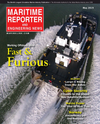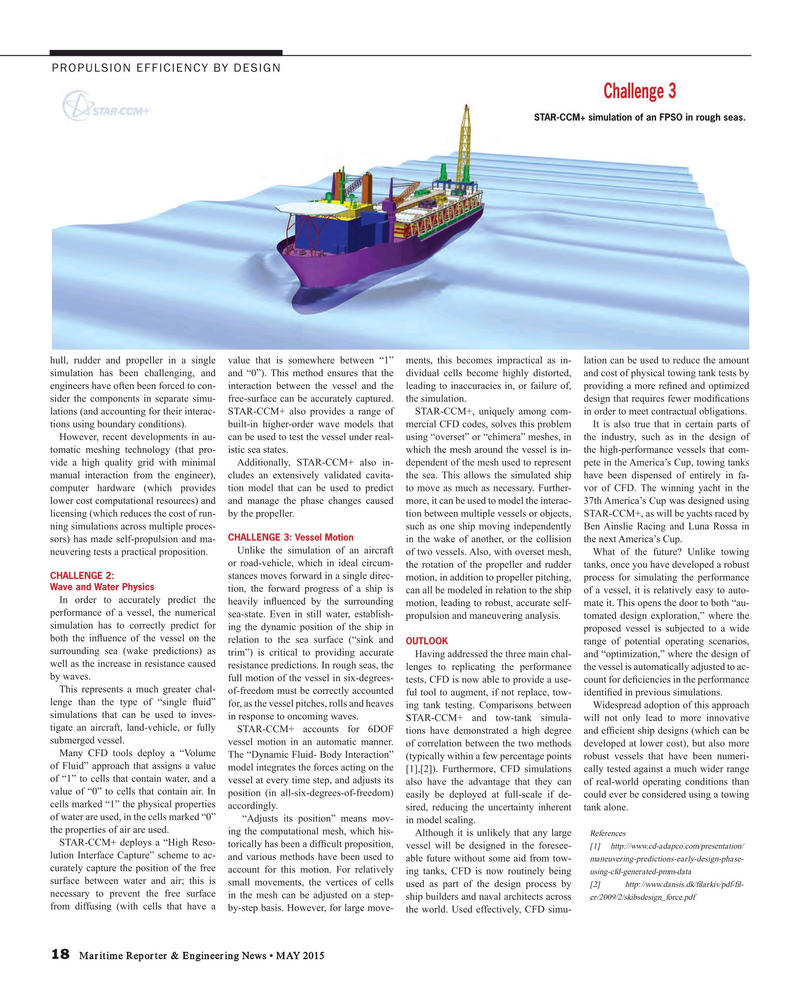
Page 18: of Maritime Reporter Magazine (May 2015)
The Marine Propulsion Edition
Read this page in Pdf, Flash or Html5 edition of May 2015 Maritime Reporter Magazine
PROPULSION EFFICIENCY BY DESIGN
Challenge 3
STAR-CCM+ simulation of an FPSO in rough seas. hull, rudder and propeller in a single value that is somewhere between “1” ments, this becomes impractical as in- lation can be used to reduce the amount simulation has been challenging, and and “0”). This method ensures that the dividual cells become highly distorted, and cost of physical towing tank tests by engineers have often been forced to con- interaction between the vessel and the leading to inaccuracies in, or failure of, providing a more re? ned and optimized sider the components in separate simu- free-surface can be accurately captured. the simulation. design that requires fewer modi? cations lations (and accounting for their interac- STAR-CCM+ also provides a range of STAR-CCM+, uniquely among com- in order to meet contractual obligations.
tions using boundary conditions). built-in higher-order wave models that mercial CFD codes, solves this problem It is also true that in certain parts of
However, recent developments in au- can be used to test the vessel under real- using “overset” or “chimera” meshes, in the industry, such as in the design of tomatic meshing technology (that pro- istic sea states. which the mesh around the vessel is in- the high-performance vessels that com- vide a high quality grid with minimal Additionally, STAR-CCM+ also in- dependent of the mesh used to represent pete in the America’s Cup, towing tanks manual interaction from the engineer), cludes an extensively validated cavita- the sea. This allows the simulated ship have been dispensed of entirely in fa- computer hardware (which provides tion model that can be used to predict to move as much as necessary. Further- vor of CFD. The winning yacht in the lower cost computational resources) and and manage the phase changes caused more, it can be used to model the interac- 37th America’s Cup was designed using licensing (which reduces the cost of run- by the propeller. tion between multiple vessels or objects, STAR-CCM+, as will be yachts raced by ning simulations across multiple proces- such as one ship moving independently Ben Ainslie Racing and Luna Rossa in
CHALLENGE 3: Vessel Motion sors) has made self-propulsion and ma- in the wake of another, or the collision the next America’s Cup.
neuvering tests a practical proposition. Unlike the simulation of an aircraft of two vessels. Also, with overset mesh, What of the future? Unlike towing or road-vehicle, which in ideal circum- the rotation of the propeller and rudder tanks, once you have developed a robust
CHALLENGE 2: stances moves forward in a single direc- motion, in addition to propeller pitching, process for simulating the performance
Wave and Water Physics tion, the forward progress of a ship is can all be modeled in relation to the ship of a vessel, it is relatively easy to auto-
In order to accurately predict the heavily in? uenced by the surrounding motion, leading to robust, accurate self- mate it. This opens the door to both “au- performance of a vessel, the numerical sea-state. Even in still water, establish- propulsion and maneuvering analysis. tomated design exploration,” where the simulation has to correctly predict for ing the dynamic position of the ship in proposed vessel is subjected to a wide both the in? uence of the vessel on the relation to the sea surface (“sink and
OUTLOOK range of potential operating scenarios, surrounding sea (wake predictions) as trim”) is critical to providing accurate
Having addressed the three main chal- and “optimization,” where the design of well as the increase in resistance caused resistance predictions. In rough seas, the lenges to replicating the performance the vessel is automatically adjusted to ac- by waves.
full motion of the vessel in six-degrees- tests, CFD is now able to provide a use- count for de? ciencies in the performance
This represents a much greater chal- of-freedom must be correctly accounted ful tool to augment, if not replace, tow- identi? ed in previous simulations.
lenge than the type of “single ? uid” for, as the vessel pitches, rolls and heaves ing tank testing. Comparisons between Widespread adoption of this approach simulations that can be used to inves- in response to oncoming waves.
STAR-CCM+ and tow-tank simula- will not only lead to more innovative tigate an aircraft, land-vehicle, or fully
STAR-CCM+ accounts for 6DOF tions have demonstrated a high degree and ef? cient ship designs (which can be submerged vessel.
vessel motion in an automatic manner. of correlation between the two methods developed at lower cost), but also more
Many CFD tools deploy a “Volume The “Dynamic Fluid- Body Interaction” (typically within a few percentage points robust vessels that have been numeri- of Fluid” approach that assigns a value model integrates the forces acting on the [1],[2]). Furthermore, CFD simulations cally tested against a much wider range of “1” to cells that contain water, and a vessel at every time step, and adjusts its also have the advantage that they can of real-world operating conditions than value of “0” to cells that contain air. In position (in all-six-degrees-of-freedom) easily be deployed at full-scale if de- could ever be considered using a towing cells marked “1” the physical properties accordingly. sired, reducing the uncertainty inherent tank alone.
of water are used, in the cells marked “0” “Adjusts its position” means mov- in model scaling.
the properties of air are used.
ing the computational mesh, which his-
Although it is unlikely that any large
References
STAR-CCM+ deploys a “High Reso- torically has been a dif? cult proposition, vessel will be designed in the foresee- [1] http://www.cd-adapco.com/presentation/ lution Interface Capture” scheme to ac- and various methods have been used to able future without some aid from tow- maneuvering-predictions-early-design-phase- curately capture the position of the free account for this motion. For relatively ing tanks, CFD is now routinely being using-cfd-generated-pmm-data surface between water and air; this is small movements, the vertices of cells used as part of the design process by [2] http://www.dansis.dk/? larkiv/pdf-? l- necessary to prevent the free surface in the mesh can be adjusted on a step- er/2009/2/skibsdesign_force.pdf ship builders and naval architects across from diffusing (with cells that have a by-step basis. However, for large move- the world. Used effectively, CFD simu- 18 Maritime Reporter & Engineering News • MAY 2015
MR #5 (18-25).indd 18 MR #5 (18-25).indd 18 4/30/2015 9:58:15 AM4/30/2015 9:58:15 AM

 17
17

 19
19
